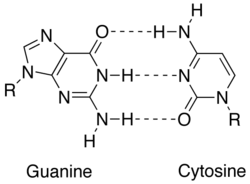
Back نيوكليوتيد مكمل Arabic Komplementarlıq (molekulyar biologiya) Azerbaijani Камплементарнасць (біялогія) Byelorussian Komplementarnost (molekularna biologija) BS Complementariedad (biología molecular) Spanish Komplementaarsusprintsiip (geneetika) Estonian Complémentarité (acide nucléique) French Complementariedade (bioloxía molecular) Galician Complementarità Italian 相補性 (分子生物学) Japanese


In molecular biology, complementarity describes a relationship between two structures each following the lock-and-key principle. In nature complementarity is the base principle of DNA replication and transcription as it is a property shared between two DNA or RNA sequences, such that when they are aligned antiparallel to each other, the nucleotide bases at each position in the sequences will be complementary, much like looking in the mirror and seeing the reverse of things. This complementary base pairing allows cells to copy information from one generation to another and even find and repair damage to the information stored in the sequences.
The degree of complementarity between two nucleic acid strands may vary, from complete complementarity (each nucleotide is across from its opposite) to no complementarity (each nucleotide is not across from its opposite) and determines the stability of the sequences to be together. Furthermore, various DNA repair functions as well as regulatory functions are based on base pair complementarity. In biotechnology, the principle of base pair complementarity allows the generation of DNA hybrids between RNA and DNA, and opens the door to modern tools such as cDNA libraries. While most complementarity is seen between two separate strings of DNA or RNA, it is also possible for a sequence to have internal complementarity resulting in the sequence binding to itself in a folded configuration.